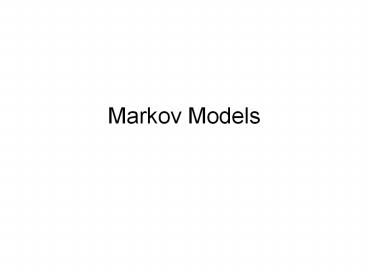Markov Models PowerPoint PPT Presentation
Title: Markov Models
1
Markov Models
2
Agenda
- Homework
- Markov models
- Overview
- Some analytic predictions
- Probability matching
- Stochastic vs. Deterministic Models
- Gray, 2002
3
Choice Example
- A person is given a choice between ice cream and
chocolate. - The person can be
- Undecided.
- Choose ice cream.
- Choose chocolate.
- There is some probability of going from being
undecided to - Staying undecided and giving no decision.
- Choosing ice cream.
- Choosing chocolate.
4
Markov Processes
- States
- The discrete states of a process at any time.
- Transition probabilities
- The probability of moving from one state to
another. - The Markov property
- How a process gets to a state in unimportant. All
information about the past is embodied in the
current state.
5
State Space
SIce Cream
SUndecided
SChocolate
6
Transition Probabilities
P(SUSU)1-(? ?)
SIce Cream
P(SI_CSI_C)1
P(SI_CSU)?
SUndecided
P(SCSU)?
P(SCSC)1
SChocolate
Note The transition probabilities out of a node
sum to 1. How can this model be made equivalent
to Luce Choice?
7
Transition Probabilities
P(SUSU)1-(? ?)
SIce Cream
P(SI_CSI_C)1
P(SI_CSU)?
SUndecided
P(SCSU)?
P(SCSC)1
SChocolate
P(SI_CSU) v(I_C)/(v(I_C)v(C)) P(SCSU)
v(C)/v(I_C)v(C))
8
Transparent Responses
P(SUSU)1-(? ?)
SIce Cream
P(SI_CSI_C)1
P(SI_CSU)?
SUndecided
P(RI_CSI_C)1
P(SCSU)?
P(SCSC)1
SChocolate
P(RnoneSU)1
P(RI_CSC)0
9
Transparent Responses
P(SUSU)1-(? ?)
SIce Cream
P(SI_CSI_C)1
P(SI_CSU)?
SUndecided
P(RI_CSI_C).8
P(SCSU)?
P(SCSC)1
SChocolate
P(RnoneSU)1
P(RI_CSC).2
10
State Sequence
Time
SU
SU
SU
SC
SC
Hidden
None
None
None
Choc.
Choc.
Observed
t1
t3
t4
t5
t2
11
Matrix Form of Transition Probabilities
To
SU SI_C SC
SU 1-(??) ? ?
SI_C 0 1 0
SC 0 0 1
From
12
Some Analytic Solutions
Where ?P(SI_CSU) and ?P(SCSU)
13
Some Analytic Solutions
- What happens if
- ??1?
- t1?
14
?.25, ?.4
15
More Analytic Solutions
16
?.25, ?.4
17
Problem?
- Why dont the choices sum to 1?
18
More Results
- The matrix form is very convenient for
calculations. - It is easy to calculate all moments.
- More to come with random walks
19
Pair Clustering
- Batchelder Riefer, 1980
- Free recall of clusterable pairs.
- Implements a Markov model for the probability
that a pair is clustered on a particular trial. - Are MPTs Markov models?
20
Probability Matching
- Paradigm
- Warning light
- Prediction P(R1), P(R2)
- Feedback P(E1)?, P(E2)1-?
- Typical result
- P(R1)? ?
21
Probability Matching
- Can be implemented via a Markov model.
- Assume win-stay/lose-shift paradigm
- If correct, make same prediction
- If incorrect, shift response with probability
?. - Associate an element with most recent event,
but not perfectly.
22
Next Trial
R1E1 R2E1 R1E2 R2E2
R1E1 ? 0 1-? 0
R2E1 ? ? (1- ?) ? ? (1-?) (1-?) (1-?)
R1E2 (1-?) ? ? ? (1-?)(1-?) ?(1-?)
R2E2 0 ? 0 1-?
Current Trial
- RiEj Response i and then Feedback j.
- ? Probability of Feedback 1.
- ? Probability of switching after error.
23
(No Transcript)
24
Markov Property
25
Light2
Light1
26
Markov Property
P(Honk) 0
P(Honk) 0
L1/Go
L2/Go
.7
.3
.3
L1/Stop
L2/Stop
.7
P(Honk) .3
P(Honk) .4
27
Markov Property
L1/Go
L2/Go
P(Honk) .3
P(Honk) .4
L1/Stop
L2/Stop
P(Honk) .8
P(Honk) .7
L1/Stop Repeat
L2/Stop Repeat
28
Stochastic vs. Deterministic
- Stochastic model The processes are
probabilistic. - Deterministic The processes are completely
determined.
29
Stochastic Models Imply
- Psychological events are uncertain
- Even if we had all the knowledge we needed we
could still not figure out what a person is going
to do next. - Or
30
Stochastic Models Imply
- The model does not capture all aspects of the
behavior in question - Allows the model to focus on certain parts of
behavior and ignore others. - You may believe behavior is deterministic, but
still rely on a stochastic model. - Allows the modeler to finesse some ignorance.
- OR
31
Stochastic Models Imply
- Some parts of the task are truly random
- E.g., feedback schedule from the experimenter in
a probability matching task.
32
Limitation of Stochastic Models
- You need to test them on populations of behavior,
not individual behaviors. - E.g., I gave Participant X a single choice and
she chose ice cream. - Can we test the model against this datum?

